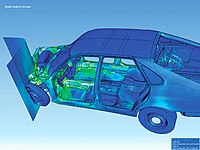
Photo from wikipedia
Abstract An effective computational method, which employs fewer strain sensors to reconstruct the Timoshenko beam under complex loads, is proposed. This method takes inverse Finite Element Method (iFEM) as a… Click to show full abstract
Abstract An effective computational method, which employs fewer strain sensors to reconstruct the Timoshenko beam under complex loads, is proposed. This method takes inverse Finite Element Method (iFEM) as a basic framework and isogeometric analysis (IGA) as an improved strategy. Initially, the kinematical equations of the Timoshenko beam are decreased to a single variable differential equation with rotation. Then, IGA can be used to describe the rotation, where the spline basis functions can be determined based on the continuity interpolation criteria. Next, relationships between rotation deformation and surface measured strains are established. Meanwhile, the geometric variables can be determined through the constitutive equations and boundary conditions. Finally, four different test loads were applied to a thin-walled aluminum beam, and the experimental results show that the presented reconstruction method has excellent accuracy than the iFEM under complex loads.
Journal Title: Measurement
Year Published: 2021
Link to full text (if available)
Share on Social Media: Sign Up to like & get
recommendations!